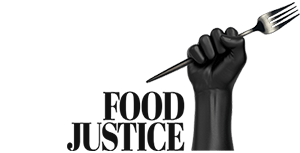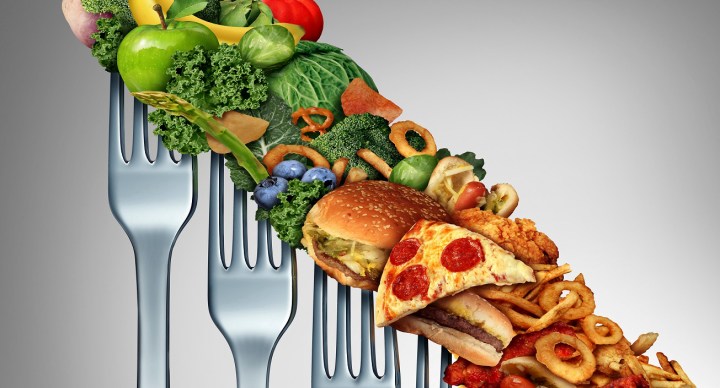
#FOODJUSTICE
SA’s exploding obesity epidemic — department of health launches draft prevention and management strategy

In South Africa, 68% of women, 31% of men and 13.5% of children are overweight or obese. Now, after a three-year delay, a draft of South Africa’s new obesity prevention and management strategy (2023-2028) is on its way to being finalised and approved. It includes a proposal that the Health Promotion Levy be extended to foods that are high in unhealthy fats, sugar and salt, as well as establishing regulations that prohibit the marketing of unhealthy foods to children. But despite the urgency, the Department of Health is vague on timeframes.
In a webinar on November 3, the National Department of Health (NDOH) presented the draft strategy, with the vision “to create a healthy food environment where healthier food choices are made easier”, said Dr Lynn Moeng-Mahlangu, NDOH Chief Director for Health Promotion, Nutrition and Oral Health.
The draft strategy is an update of the 2015-2020 strategy, for which nutrition experts and researchers have been waiting with great expectation, according to some interviewed recently by Maverick Citizen.
A first multisectoral workshop to discuss the findings and gather feedback on the review process was held in November 2021. This is the second such consultative meeting, whose purpose was to solicit further questions and inputs from non-governmental stakeholders before the strategy is finalised for approval. In South Africa, 68% of women, 31% of men and 13.5% of children are overweight or obese.
A ‘long journey’
The 2015-2020 strategy had set out to achieve a 10% reduction in the prevalence of obesity in South Africa, but government has not carried out — or has not reported to the public — a formal evaluation of this or any of the strategy’s other goals.
Dr Moeng-Mahlangu opened the 3 November session, saying:
“Our plea to all is: Make this strategy practical, feasible and implementable. Let’s all have inputs that will help us strengthen the strategy.
“There’s been a gap, obviously,” she went on, acknowledging the three-year delay, “but some of the activities from the previous strategy have been continuing.” However, she did not offer an explanation for the reasons for the delay, nor elaborate on which activities have been continuing, nor the impact of the previous strategy.
“This has been a long journey,” Moeng-Mahlangu said, describing the review and update process that began in 2021 with the establishment of the National Advisory Team on the Obesity Strategy, and the appointment of a review team of experts. The review team submitted its final report and recommendations to the NDOH at the end of January 2022. Since then, the Nutrition directorate has “consulted with other government departments,” the NDOH said, “and amended the draft updated strategy accordingly.”

In South Africa, 68% of women, 31% of men and 13.5% of children are overweight or obese. (Photo: iStock)
Director of the NDOH’s Nutrition Directorate, Rebone Ntsie, set out the draft strategy’s six main goals, emphasising that they had to be “realistic”, achievable within five years, that some would need enabling regulations to be developed, and that the main actions “should be at a strategic level, not operational”.
Some actions had been taken out of the draft, Ntsie said, for example, the provision of safe water in schools, because “the actions need to impact directly on obesity”. (However, obesity experts believe that safe drinking water in schools should in any case be non-negotiable, confirming that the presence of safe drinking water in schools has a direct impact on obesity prevention and management. For example, recent research, carried out in more than 100 Gauteng schools, shows that even when a major beverage company made a voluntary pledge, in 2017, to discontinue sales of sugar-sweetened beverages to schools, there was no substitution with healthier-drink alternatives, such as bottled water.)
Six strategic goals
Unicef’s Josee Koch presented slides laying out each goal’s strategic objectives, main activities, and intended outcomes, before opening to questions on each goal.
- The first goal is “an enabling environment exists in which healthy food is promoted, available and easily accessible in workplaces and in schools.” “Workplaces” seems to refer only to government settings and public institutions such as hospitals and prisons.
- The second goal is to ensure that “an enabling environment is in place to facilitate equitable access to physical activity opportunities.” Community buy-in and free physical activity facilities are the two strategic objectives of this goal.
- The third goal aims to ensure that “education and communication at different levels is evidence-based to prevent and manage obesity.”
- The fourth goal is to ensure “the healthcare system is equipped to address obesity prevention and management including capacity building for healthcare workers and community health workers.
- The fifth goal is to ensure “an effective monitoring, evaluation and research system is in place.” This will include mid- and end-term evaluations of the strategy’s implementation and impact. (This goal is especially noteworthy, given the absence of monitoring, evaluation and follow-up for the 2015-2020 strategy.)
- Goal six aims for policy and legislation (to be created) to support a healthy food environment. This will include extending the Health Promotion Levy — the tax on sugar-sweetened beverages — to foods that are high in unhealthy fats, sugar and salt, as well as establishing regulations that prohibit the marketing of unhealthy foods to children.
Restricting advertising of unhealthy products
In 2012, the World Health Organization recommended guidelines for restricting the marketing and advertising of all unhealthy products to children, with more recent updates including social media and digital marketing guidelines.
The NDOH’s attempt to include these restrictions in the 2023-2028 strategy will start with the establishment of a ‘“nutrient profiling model” that would set the baseline for what are considered “healthy” or “unhealthy” amounts of nutrients such as sugars, unhealthy fats and salt. This will enable marketing restrictions to be based on the standardised version of what is considered “unhealthy”, and front-of-pack labelling (FOPL) for all packaged foods will enable apples-to-apples comparisons.
The marketing restrictions goal will be of critical importance to long-term progress on obesity prevention and management, as scientific evidence from other low- and middle-income countries such as Mexico, Chile, Thailand and Indonesia has shown how effective such restrictions and effective labelling can be in influencing consumers’ choice to buy healthier foods.
After the presentations, participants submitted questions relating to each goal. Issues highlighted include: safety concerns for people exercising more outdoors; conflicts of interest regarding private-sector sponsorships of school sports and other activities; unhealthy foods are more affordable than healthy foods; linkages between community health workers, schools and health facilities; transparency of any monitoring and evaluation efforts; how the anti-obesity strategy links to the non-communicable diseases strategy; and how the strategy intends to create demand for healthy foods rather than focusing more on reducing the consumption of unhealthy foods.
Moeng-Mahlangu and Ntsie said all inputs were being noted, but verbal and online responses were, at times, terse and unsatisfactory in their scope and rationale.
For example, in response to Maverick Citizen asking what the timeframe is for getting the supporting regulations in place (such as extending the HPL to other unhealthy foods, and imposing restrictions on the marketing of unhealthy foods to children) Ntsie said the regulatory framework would be in place “within the five-year period” of the strategy.
Visit Daily Maverick’s home page for more news, analysis and investigations
Another participant asked whether the HPL is now ring-fenced for health promotion (it has not been, so far).
“What we have heard from the Treasury with a lot of other levies,” Moeng-Mahlangu answered, “is that ring-fencing is very challenging because if you’re not using that money for that purpose then you can’t use it for anything else. It’s a ‘soft’ ring-fencing which means it can be used for other purposes.”
In June 2022, Sars told Maverick Citizen that since its introduction in 2018, the HPL has raised more than R10-billion in revenues.
Moeng-Mahlangu did not elaborate on why the HPL money may not have been used for its original intended purpose — ie health promotion broadly; obesity — and NCD prevention and management, specifically — nor why it should be used for other purposes, or what those other purposes might be.

Experts say big food advertising, targeting children, is a growing concern globally that needs to be addressed immediately as it manipulates children into choosing unhealthy fast food while infringing on children’s right to health. (Photo: takepart.com / Wikipedia)
Maverick Citizen then asked whether the many billions in revenue collected so far from the HPL would be used to subsidise a “healthy food basket”, for Child Support Grant Recipients, for example. Ntsie said, “We note [this] and we will take it to Treasury to see if they can buy into that and maybe advocate for that.”
Another question was how the private sector could get involved, and Ntsie’s response was, “For schools, engage with the Department of Basic Education. We do work with the private sector but not to promote a particular product.”
This answer on the one hand seemed to pass the buck rather than exemplify the cross-departmental approach the draft strategy claims to take. On the other, it addressed only very narrowly the risks of private-sector involvement (based on previous, branded sponsorships of schools by global sugary-drink brands) rather than taking into account the huge scope of opportunity for constructive partnerships with the private sector to support the new strategy — for example with consultation with food-and-beverage actors about marketing healthier foods, or with non-product-related professional services in implementing the strategy’s activities.
“Maybe your question has not been answered directly,” Ntsie said to all attendees, “but when we develop the operational plan we will consider the comments made and the questions put, and we will also have further engagement when the operational plans are developed and that will be from next April.”
The NDOH says it will ensure that the strategy is finalised and approved by the end of March 2023 and then published.
“The approval is not a process that depends on us,” Ntsie added. “I must tell you that it goes through several committees and the National Health Council with MECs — but we are doing all we can from our side to ensure that we are able to submit our strategy on time.”
Ntsie emphasised that what the NDOH is hoping for in the final strategy are “evidence-based interventions that are realistic and that we will be able to implement”.
One member of the 2015-2020 strategy-review team who preferred to remain anonymous had previously told Maverick Citizen that since the team’s January 2022 submission of their recommendations, they did not know what to expect in the new draft, as the NDOH had not communicated to them which of their recommendations had been included in the “amended” strategy. DM/MC
A recording of the November 3 consultation on the Draft Updated Strategy for Prevention and Management of Obesity 2023-2028 is available at www.knowledgehub.org.za.


















 Become an Insider
Become an Insider
Comments - Please login in order to comment.